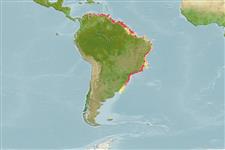Classification / Names
Common names from other countries
Main reference
Size / Weight / Age
Max length : 110 cm TL male/unsexed; (Ref. 40637); common length : 45.0 cm TL male/unsexed; (Ref. 3702); max. published weight: 17.0 kg (Ref. 40637)
Length at first maturity
Lm 42.7 range ? - ? cm
Environment
Marine; freshwater; brackish; demersal; oceanodromous (Ref. 51243); depth range 1 - 20 m (Ref. 3702)
Climate / Range
Subtropical, preferred ?; 13°N - 40°S, 80°W - 34°W
Distribution
Short description
Dorsal
spines
(total): 11;
Dorsal
soft rays
(total): 17-22;
Anal
spines: 2;
Anal
soft rays: 7 - 9. Body nearly uniform silvery, dark greenish above. Without conspicuous spots on side but with diffuse dark areas along base of dorsal fin and on margin of spinous dorsal fin, ventral side of head, lower margin of pectoral, pelvic, and caudal fins often yellowish orange. Inside of opercle dusky. Mouth large, oblique. Lower jaw slightly projecting. Upper jaw with a pair of large canine-like teeth at tip. Lower jaw with a row of enlarged inner-row teeth, gradually increasing in size posteriorly. Chin without barbels or pores. Snout with 2 marginal pores. Pectoral fins about equal in length to pelvic fins. Gas bladder with a pair of long, straight, horn-like appendages. Sagitta earstone thin and elongate. Soft portion of dorsal fin unscaled except 2 or 3 rows of small scales along its base (Ref 51271).
IUCN Red List Status (Ref. 115185)
Threat to humans
Harmless
Human uses
Fisheries: commercial; gamefish: yes; aquarium: commercial
More information
ReferencesAquacultureAquaculture profileStrainsGeneticsAllele frequenciesHeritabilityDiseasesProcessingMass conversion
Tools
Special reports
Download XML
Internet sources
Estimates of some properties based on models
Phylogenetic diversity index
PD50 = 0.5000 many relatives (e.g. carps) 0.5 - 2.0 few relatives (e.g. lungfishes)
Trophic Level
4.1 ±0.70 se; Based on food items.
Resilience
Medium, minimum population doubling time 1.4 - 4.4 years (K=0.27)
Vulnerability
Moderate to high vulnerability (45 of 100)
Price category
